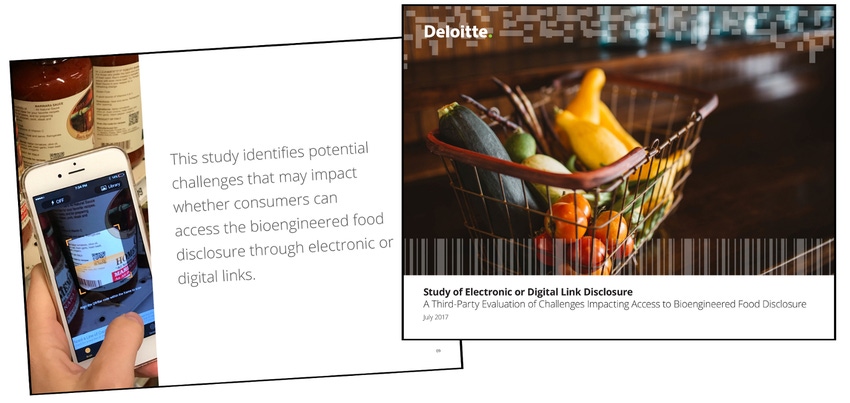USDA sets new labeling disclosures for bio-engineered foods
October 13, 2017

The National Bioengineered Food Disclosure Law—signed into law on July 29, 2016—directs the U.S. Department of Agriculture (USDA) to develop regulations and standards to create mandatory disclosure requirements for bio-engineered foods by July 2018. Recent developments include input from stakeholders on how the mandatory disclosure requirements should be structured and the release of a study on electronic disclosure.
Even though USDA is responsible for promulgating the labeling and disclosure requirements, the practical scope of the law covers all food products, but ironically enough, excludes fresh meat, poultry and egg products, as well as processed products in which meat, poultry and eggs are the primary ingredients. Traditionally, USDA jurisdiction resides over exactly those products, with the Food and Drug Administration (FDA) having authority over the other products.
Under the new law, food companies have three options to disclose genetically modified (GM) ingredients:
1. The use of on-package text;
2. A USDA-created symbol;
3. An electronic link—that is, a quick-response (QR) code printed on the package that directs customers to GM information.
A small food manufacturer may provide a telephone number or internet website where consumers can obtain additional information instead of these three options.
In addition, USDA was directed to conduct a study by July 29, 2017, to identify “potential technological challenges that may impact whether consumers would have access to the bioengineering disclosure through electronic or digital disclosure methods.”
On Aug. 25, 2017, public interest group Center for Food Safety, which has repeatedly expressed concerns that electronic communications will not provide disclosure to a large portion of Americans, filed a lawsuit alleging that USDA violated the Administrative Procedures Act because it “failed to publicly release the study, or provide for public comment on it.” Shortly after the lawsuit was filed, on Sept. 6, 2017, USDA release the mandated study (the Study of Electronic or Digital Link Disclosure).
The study found that the majority of Americans own a smartphone (77%), with ownership rates trending upward, and that most Americans live in areas with sufficient broadband access (93.6%) to scan a digital link to access bioengineering food disclosure information.
However, the study also found that consumers lack familiarity with scanning. For example, 85% of consumers experience technical challenges using certain mobile software applications (apps) for scanning digital links. Another potential problem is that scanning digital links requires access to the internet and not all consumers have access to cellular data or local Wi-Fi networks and only 37% of small retailers currently provide Wi-Fi to consumers in store.
USDA receives public input
This past June, USDA’s Agricultural Marketing Service (AMS) posted a list of 30 questions to obtain stakeholder input to facilitate the drafting of mandatory disclosure requirements. The questions ranged from ones concerning terminology and definitions to ones on disclosures, exemptions and compliance. Responses to the questions were due by Aug. 25, 2017.
USDA has not yet posted the comments it received; however, several organizations have posted the comments they submitted in response to USDA’s questions. Not surprisingly, opinions vary on how the requirements should be structured. For example, opposing opinions were expressed on the question: “Will AMS require disclosure for food that contains highly refined products, such as oils or sugars derived from bioengineered crops?”
Among the organizations responding that disclosure should be required were the Grocery Manufacturers Assn. (GMA), the International Dairy Foods Assn. (IDFA) and the Consumers Union. Noting that excluding highly refined ingredients (HRI) from the scope of the mandatory disclosure standard would result in roughly 80% fewer products being subject to the disclosure requirements under the federal law, GMA wrote, “A clear, simple, and consistent mandatory disclosure standard that includes HRI will assist manufacturers in educating consumers about biotechnology as a safe and beneficial method of plant breeding.”
In contrast, the Information Technology & Innovation Foundation (ITIF) and The Biotechnology Innovation Organization (BIO) are opposed to mandatory disclosure of HRI. BIO further stated that the term “highly refined products” should be replaced with “refined ingredients,” since the terms “highly processed” or “highly refined” typically refer to “multi-ingredient mixtures processed to the extent that they are no longer recognizable as their original plant/animal source,” rather than a single isolated food component, such as sugar or oil.
A full list of the questions can be found on the AMS-USDA website.
As USDA moves forward with the development of mandatory disclosure requirements for bio-engineered foods, there will be a number of challenges to overcome. These include concerns about consumers’ ability to access information through electronic or digital links, diverse opinions on how the requirements should be structured, and the potential impact on consumer buying and eating habits.

Author George Misko is a partner at Keller and Heckman. Founded in 1962, the respected law firm has a broad practice in the areas of regulatory law, litigation and business transactions, serving both domestic and international clients. Reach him at [email protected].
About the Author(s)
You May Also Like


